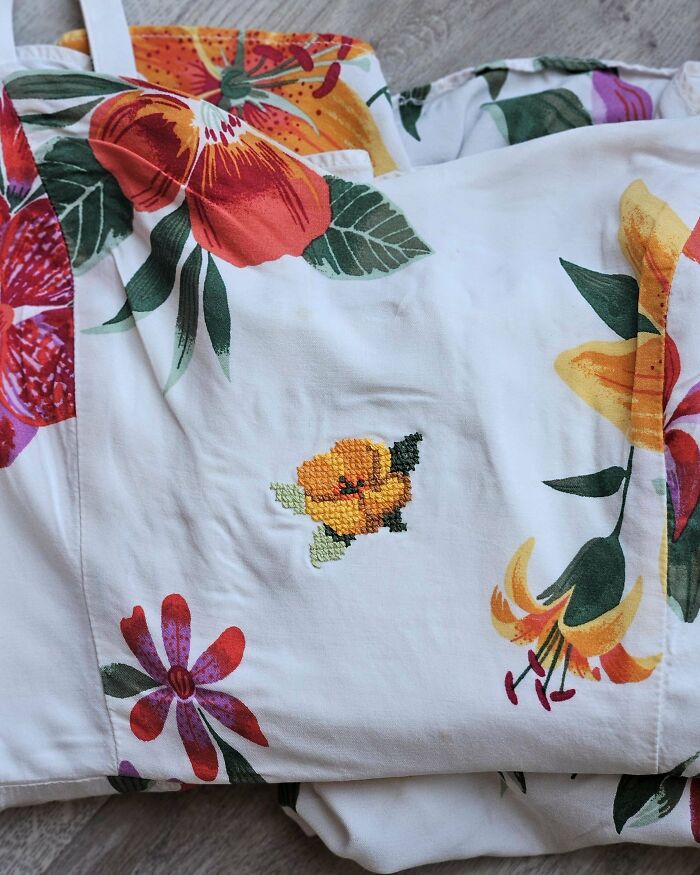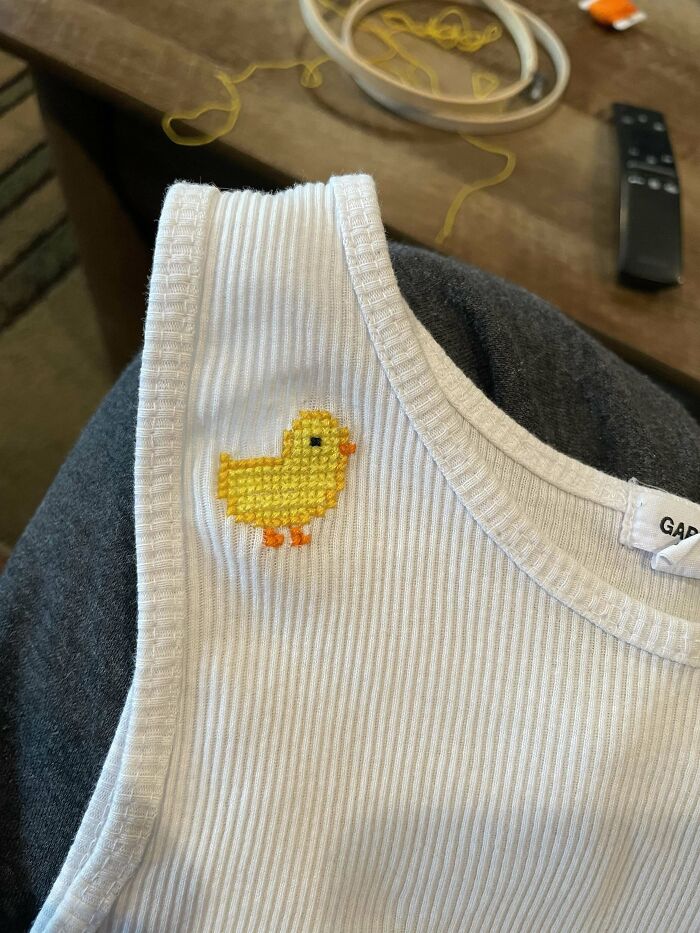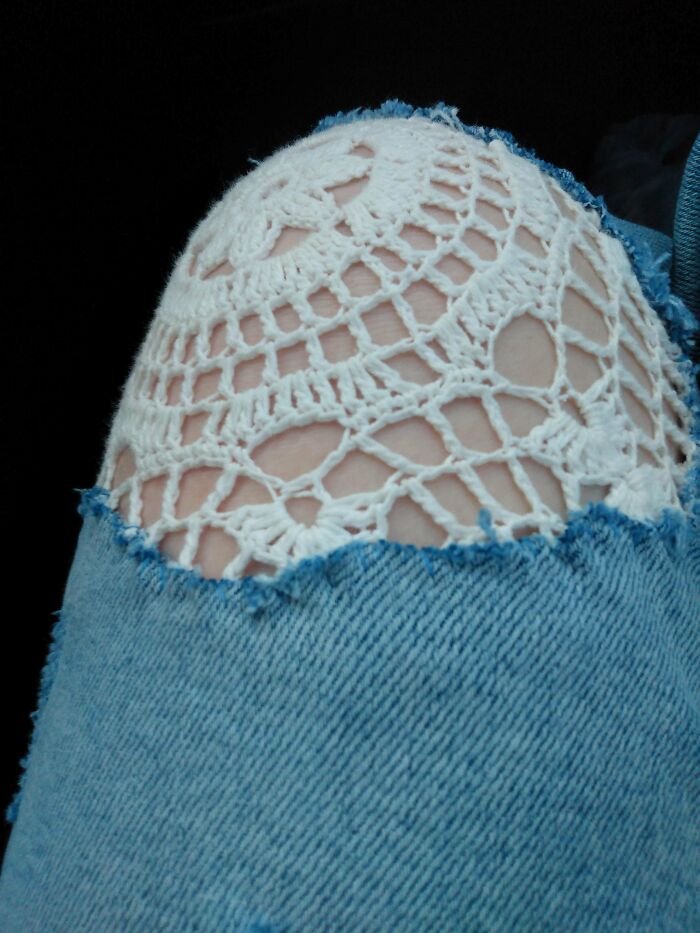Just because something gets broken, torn, or old doesn't mean we need to throw it away. 92 million tonnes of textile waste ends up in landfills in the U.S. every year as it is. But there are ways to prolong the life of an item of clothing. One of them is mending, and it can be quite an art form, too.
People in this Reddit community know that. They're into what's called 'visible mending,' the art of repairing clothes, furniture, textiles, and in some cases even cars by displaying their flaws instead of hiding them. So, scroll through this list of stunning mending projects and perhaps it'll inspire you to prolong your garment's life too!
To know more about the benefits and joys of visible mending, Bored Panda reached out to fiber artist and author of Mending Matters and Make Thrift Mend Katrina Rodabaugh. She kindly agreed to tell us why mending clothes instead of throwing them away can be so joyous and shared some practical tips for aspiring menders. Read her insights below!
#1 Third Attempt At Darning!

Image credits: Guilty_Piglet5731
#2 Short Had Holes. Made Some Fish About It

Image credits: ImmunoComplements
#3 Really Happy With How This Came Out, Dandelion Seed Head Over Some Small Tears In A Shirt

Image credits: Hippophae
When I was little, my grandma used to darn the socks for our entire family. Granted, she was the one who knit them in the first place, but she was also the one who would repair them when there would be nothing but big holes left in the heels. Back when she was growing up, there was no such thing as fast fashion. Even suggesting to throw the socks out would've seemed incredibly wasteful.
Luckily, it seems that mending is coming back in style. Patrick Grant, the host of The Great British Sewing Bee, told The Guardian that people are getting tired of the fast fashion industry and looking for alternatives. "I think this trend has been growing for several years now and I think it's largely been driven by our desire to consume less and throw less away for environmental reasons."
#4 Embroidered Couch Repair!

Image credits: antekamnia
#5 Fixed A Small Hole In The Sleeve Of My Boyfriend’s Jacket. Do I Tell Him Or Let Him Find It?

Image credits: Cute-Significance758
#6 I Covered Up A Wine Stain On My Favorite Dress With A Cross Stitch Flower (X-Post From /R/Crossstitch)

Image credits: aly5321
The wish to be more eco-friendly is one of the reasons artist and author Katrina Rodabaugh turned to mending as well. "I love so many things about mending clothes!" she tells Bored Panda. "Mostly, it repairs the textile and puts it back into rotation and prolongs its usefulness. It's better for the environment if I'm able to wear my clothes for as long as possible and reduce waste."
However, there's the crafting aspect as well. "I also love that it allows for experimentation with simple design elements like color, line, and scale," Katrina says. "I love that it's calming, centering, and quiet. And I love that it lets me practice basic stitching and patching—a micro session of crafting in a full day."
#7 First Visible Mend!

Image credits: Kamtasticality
#8 Patched A Hole In The Crotch Of My Jeans

Image credits: gnome_census
#9 My Boyfriend’s Mom Had A Medical Emergency And The Emts Cut Her Favorite Jacket. I Mended It For Her Christmas Present

Image credits: safety_pin_era
When you're a beginner at mending and have never done a stitch in your life, it can be hard to navigate the world of crafts. Especially if you're trying to be more sustainable and friendly to the environment; knowing what tools and materials to choose for mending matters. You wouldn't want to go for a polyester or nylon thread when your goal is to reduce the use of synthetic fibers.
#10 Fixed Some Holes With Bees

Image credits: Knautia-arvensis
#11 First Attempt At Sashiko, Covering A Grouping Of Stubborn Stains

Image credits: freshahava
#12 Advice Please! A Great Idea Or Absolutely Horrendous?!

Image credits: PearlWhite24
Katrina says that you don't need much to start mending. "Most of my mending materials are quite simple—thread, needle, yarn, patches, scissors, thimble, and a ruler," she tells us. "I love that the tools are not highly specialized and are common enough that most folks can access them easily."
#13 Had A Stain On A Shirt, Fixed It With A Little Ducky!

Image credits: Alarmed_Shoulder_386
#14 Denim Opus Complete!

Image credits: kittyissocrafty
#15 My Favorite Pair Of Shorts Ripped And So I Thought I’d Give Vm A Try

Image credits: strawberrymystic
When it comes to fibers, Katrina prefers to go natural. "I opt for biodegradable fibers like cotton, linen, and wool to reduce my use of synthetics, whenever possible." She recommends using castoff clothes or remnant fabrics when you're making patches. That works really well for mending woven garments like denim.
#16 I Sewed Some Doilies Into Both Knees Of My Jeans (My First Mend Ever)!

Image credits: DataHasRedHair
#17 My First Visible Mend And First Embroidery Ever!

Image credits: _Something_Classy
#18 The Adhesive That Holds Together The Covering On My Headphones Ear Cups Came Apart

Image credits: MainlandX
And what about fixing knitted or crocheted garments? "If I'm darning knits, it's great fun to plant-dye tiny skeins of wool yarn to use for special mending projects—though leftover yarn from knitting projects is great too." People can either use store-bought natural plant dye extracts or experiment with homemade options like coffee, black tea, or onion skins.
#19 Added A Little Strawberry To My Daughter’s Damaged Shorts

Image credits: momHandJobDotCom
#20 Ripped Jeans

Image credits: vera_luna
#21 A Snail To Fix A Torn Pocket Corner

Image credits: pahein-kae
If this list inspired you to try visible mending, Katrina has some useful tips about where to start. "Try to match the fiber of the textile you're mending with the fiber in the patch and thread," she recommends. "If you're mending mid-weight denim jeans, try to use a mid-weight denim patch and mid-weight cotton thread. If you're darning a bulky sweater, use bulky yarn."
#22 Cold Snap Here, So I Needed To Patch A Hole In Favorite Winter Coat

Image credits: Responsible-Aside-18
#23 First Time Mending & Embroidering!

Image credits: _megaronii_
#24 Mended My Toddler's Shirt With Some Mushrooms!

Image credits: wollphilie
A mistake many beginners can make is to use a patch the size of the hole they're mending. Katrina points out that the patch or darn should always be bigger than the hole or fray. "It needs to attach to the undamaged part of the textile so make the repair bigger than the hole. You can always practice your stitches on a fabric scrap to help warm up."
#25 Darning Pattern

Image credits: Sea_Solution_9837
#26 Salvaging A Sentimental Sweatshirt

Image credits: Stick-Senior
#27 Rescued My Favourite Hoodie

Image credits: Not4mebut2u
Nobody's born an expert, so don't get upset when you fail. There's no superglue in mending; you can always fix a mistake. "Remember that they are just stitches and you can take them out and start over if you like," Katrina says. "The more you stitch, the more you'll get comfortable with your stitches, like handwriting. Mend things and have fun!"
#28 Been Going Through It; Mending My Clothes As An Attempt To Mend My Self

Image credits: sparklesquidd
#29 I Thought You Guys Might Appreciate My Pants

Image credits: helchowskinator
#30 Promised To Mend My Husband's Pants Forever

Image credits: incitatus24
Have you ever attempted visible mending, Pandas? Let us know how it went! If you get inspired by this list, don't hesitate to share your experiences with fellow Pandas in the comments as well. And if you're looking for more cool pics from the r/VisibleMending subreddit, check out our previous articles about them here and here!







